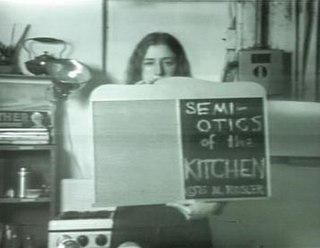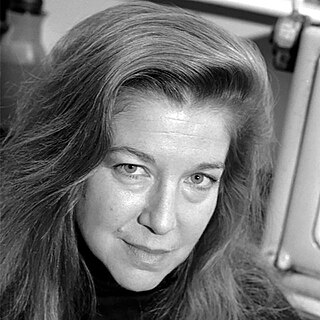Related Research Articles

Kathryn Ann Bigelow is an American filmmaker. Bigelow has received numerous accolades including two Academy Awards, two BAFTA Awards, and a Primetime Emmy Award. Time magazine named her one of the 100 most influential people in the world in 2010.

Shigeko Kubota was a Japanese video artist, sculptor and avant-garde performance artist, who mostly lived in New York City. She was one of the first artists to adopt the portable video camera Sony Portapak in 1970, likening it to a "new paintbrush." Kubota is known for constructing sculptural installations with a strong DIY aesthetic, which include sculptures with embedded monitors playing her original videos. She was a key member and influence on Fluxus, the international group of avant-garde artists centered on George Maciunas, having been involved with the group since witnessing John Cage perform in Tokyo in 1962 and subsequently moving to New York in 1964. She was closely associated with George Brecht, Jackson Mac Low, John Cage, Joe Jones, Nam June Paik, and Ay-O, among other members of Fluxus. Kubota was deemed "Vice Chairman" of the Fluxus Organization by Maciunas.

Semiotics of the Kitchen is a feminist parody single-channel video and performance piece released in 1975 by Martha Rosler. The video, which runs six minutes, is considered a critique of the commodified versions of traditional women's roles in modern society.
TVTV was a San Francisco-based video collective that produced documentary video works using guerrilla art techniques.
Shelly Silver is an American artist who works with film, video, and photography. Her art has been exhibited and broadcast throughout the U.S., Europe and Asia. She is Associate Professor of Visual Arts at Columbia University School of the Arts.
Rea Tajiri is an American video artist, filmmaker, and screenwriter, known for her personal essay film History and Memory: For Akiko and Takashige (1991).

Video Data Bank (VDB) is an international video art distribution organization and resource in the United States for videos by and about contemporary artists. Located in Chicago, Illinois, VDB was founded at the School of the Art Institute of Chicago in 1976 at the inception of the media arts movement.
Elisabeth Subrin is a Brooklyn-based filmmaker, screenwriter, and visual artist. She is known for her interdisciplinary practice in the contemporary art and independent film worlds. She is a professor in Temple University's Department of Film and Media Arts. Her feature length narrative film A Woman, a Part; starring Maggie Siff, Cara Seymour, John Ortiz, and Khandi Alexander; premiered at The Rotterdam Film Festival in 2016. She is also the creator of the blog, Who Cares About Actresses, dedicated to actress Maria Schneider.
Skip Blumberg is an American filmmaker. He is one of the original camcorder-for-broadcast TV producers, and among the first wave of video artists in the 1970s. His early work reflects the era's emphasis on guerrilla tactics and medium-specific graphics, but his more recent work takes on more global issues. His work has screened widely on television and at museums. His video Pick Up Your Feet: The Double Dutch Show (1981) is considered a classic documentary video and was included in the Museum of Television and Radio's exhibition TV Critics' All-time Favorite Shows. His cultural documentaries and performance videos have been broadcast on PBS, National Geographic TV, Showtime, Bravo, Nickelodeon, among others.
Susan Mogul is an American artist primarily known for her work in video art. She also works in photography, installation art, and performance art. Originally from New York City, she currently lives and works in Los Angeles, CA.

Dimitri Devyatkin is an American director, producer, screenwriter, video artist, and journalist. Devyatkin uses elements of humor, art and new technology in his work. He is known as one of the first video makers to combine abstract synthesized imagery with camera footage. His programs have been broadcast domestically and internationally on ABC, PBS, Channel 4, WDR, France 3, TF1 and Channel One Russia. His works consist of digital media, computer art, broadcast news and feature filmmaking. His activities in the creation of new independent US filmmaking have been documented by Jonas Mekas in "Birth of a Nation" (1997).

Kristin Lucas is a media artist who works in video, performance, installation and on the Internet. Her work explores the impacts of technology on humanity, blurring the boundary between the technological and corporeal. In her work she frequently casts herself as the protagonist in videos and performances where her interactions with technology lead to isolation, and physical and mental contamination.

Cassie Jaye is an American film director, best known for directing the 2016 documentary film The Red Pill about the men's rights movement.
Frank Gillette is an American video and installation artist. Interested in the empirical observation of natural phenomena, his early work integrated the viewer's image with prerecorded information. He has been described as a "pioneer in video research [...] with an almost scientific attention for taxonomies and descriptions of ecological systems and environments". His seminal work Wipe Cycle –co-produced with Ira Schneider in 1968– is considered one of the first video installations in art history. Gillette and Schneider exhibited this early "sculptural video installation" in TV as a Creative Medium, the first show in the United States devoted to Video Art. In October 1969, Frank Gillette and Michael Shamberg founded the Raindance Corporation, a "media think-tank [...] that embraced video as an alternative form of cultural communication.

Joan Braderman is an American video artist, director, performer, and writer. Braderman's video works are considered to have created her signature style known as "stand up theory." Via this "performative embodiment," she deconstructs and analyzes popular media by inserting chroma-keyed cut-outs of her own body into appropriated mass media images, where she interrogates the representation of ideology and the transparency of photographic space in U.S. popular culture.

Bertha "Betsy" Bakker-Nort was a Dutch lawyer and politician who served as a member of the House of Representatives for the Free-thinking Democratic League (VDB) from 1922 to 1942.
Kate Horsfield, is an American artist who focused her work on video art and video documentation. She is also an author and teacher. She is best known for co-founding the Video Data Bank in 1976, an international video art distribution organization with Lyn Blumenthal.
Shalom Gorewitz is an American visual artist. Gorewitz was among the first generation of artists who used early video technology as an expressive medium. Since the late 1960s, he has created videos that "transform recorded reality through an expressionistic manipulation of images and sound". His artworks often "confront the political conflicts, personal losses, and spiritual rituals of contemporary life". Gorewitz has also made documentary and narrative films.
Rita Myers is an American video installation artist. Her work is held in the collection of the Museum of Modern Art in New York.

Ed Bowes is a filmmaker, writer, and director who pioneered the use of video as cinema. The first person to make a feature-length film in video, he used poets, musicians, artists, video- and filmmakers as performers in films such as Romance (1975) and Better, Stronger (1978–79). As a result of the notice given to his camera work, Bowes began his long career as a cinematographer for filmmakers and video artists including Kathryn Bigelow, Lizzie Borden, Vito Acconci, and Robert Longo, among others. In the 1970s, he was instrumental in creating early exhibitions of video art at MoMA, The Kitchen, and other Downtown New York venues. He taught advanced filmmaking for more than three decades at the School of Visual Arts, where he influenced several generations of contemporary filmmakers. His work is in the collection of The Museum of Modern Art, New York, and Moderna Museet in Stockholm, Sweden. It is also represented in The Kitchen Archive at The Getty Research Institute and the Long Beach Museum of Art Video Archive.
References
- ↑ DeVito, Cara. "LinkedIn Profile". LinkedIn. LinkedIn. Retrieved 26 April 2015.
- ↑ "Nieman Class of 1998". Nieman Foundation. Harvard University. Retrieved 26 April 2015.
- ↑ DeVito, Cara. "Google+". Google+. Retrieved 28 April 2015.
- ↑ "Cara DeVito". Video Data Bank. VDB. Retrieved 24 April 2015.
- 1 2 3 4 Cara, DeVito. "resume". Indeed.
- 1 2 "Ama L'Uomo Tuo". Electronic Arts Intermix. EAI. Retrieved 24 April 2015.
- ↑ "Cara DeVito". Electronic Arts Intermix. EAI. Archived from the original on 21 January 2011. Retrieved 24 April 2015.
- 1 2 3 4 "Ama L'Uomo Tuo". Video Data Bank. VDB.
- ↑ "Liborio Logiudice". Crestleaf.
- ↑ Curtis, Cathy (January 28, 1993). "EXTENDED FAMILY : UCI Exhibit Offers Hours of Videotapes and Multiple Viewpoints on Blood Relations". Los Angeles Times. Retrieved 28 April 2015.
- ↑ "Cara DeVito". Video Data Bank. VDB.
- 1 2 Gever, Martha (1985). "Video Politics, Early Feminist Projects". Cultures in Contention. The Real Comet press.